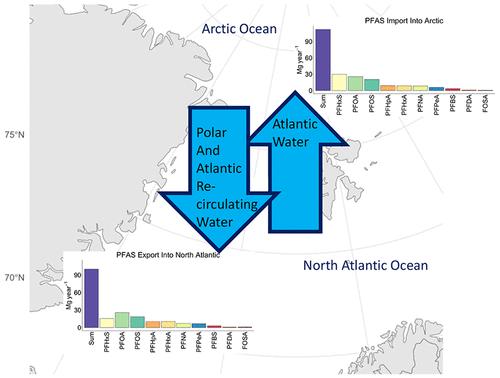当前位置:
X-MOL 学术
›
Environ. Sci. Technol. Lett.
›
论文详情
Our official English website, www.x-mol.net, welcomes your feedback! (Note: you will need to create a separate account there.)
Passive Sampler Derived Profiles and Mass Flows of Perfluorinated Alkyl Substances (PFASs) across the Fram Strait in the North Atlantic
Environmental Science & Technology Letters ( IF 10.9 ) Pub Date : 2024-01-10 , DOI: 10.1021/acs.estlett.3c00835 Matthew Dunn 1 , Simon Vojta 1 , Thomas Soltwedel 2 , Wilken-Jon von Appen 2 , Rainer Lohmann 1
Environmental Science & Technology Letters ( IF 10.9 ) Pub Date : 2024-01-10 , DOI: 10.1021/acs.estlett.3c00835 Matthew Dunn 1 , Simon Vojta 1 , Thomas Soltwedel 2 , Wilken-Jon von Appen 2 , Rainer Lohmann 1
Affiliation

|
Per- and polyfluorinated alkyl substances (PFAS) are a family of pollutants of high concern due to their ubiquity and negative human health impacts. The long-range marine transport of PFAS was observed during year-long deployments of passive tube samplers in the Fram Strait across three depth transects. Time weighted average concentrations ranged from 2.4 to 360 pg L–1, and 10 different PFAS were regularly observed. PFAS profiles and concentrations were generally similar to those previously characterized for polycyclic aromatic hydrocarbons (PAHs) at these sites. The detection of several anionic PFAS in “old” water demonstrated that they are not perfect water mass tracers but are also transported to depth via settling particles. Mass flows of PFAS through the Fram Strait in and out of the Arctic Ocean were basically similar (112 ± 82 Mg year–1 northward flow, 100 ± 54 Mg year–1 southward flow). For perfluorooctane sulfonamide (FOSA), export from the Arctic Ocean via the Fram Strait exceeded import by Atlantic Water, likely due to preferential transport and deposition in the Arctic Ocean. These observations suggest that PFAS in the Arctic are governed by the feedback loop previously described for polycyclic aromatic hydrocarbons (PAHs) in the region─with additional atmospheric transport delivering volatile PFAS to the Arctic, which then get exported via Arctic water masses.
中文翻译:

被动采样器得出的北大西洋弗拉姆海峡全氟烷基物质 (PFAS) 的剖面和质量流量
全氟烷基物质和多氟烷基物质 (PFAS) 是一类受到高度关注的污染物,因为它们普遍存在并对人类健康产生负面影响。在弗拉姆海峡跨三个深度横断面部署被动管采样器长达一年的过程中,观察到了 PFAS 的远距离海洋迁移。时间加权平均浓度范围为 2.4 至 360 pg L –1,并定期观察到 10 种不同的 PFAS。PFAS 分布和浓度总体上与之前在这些地点表征的多环芳烃 (PAH) 相似。在“旧”水中检测到的几种阴离子 PFAS 表明,它们并不是完美的水质示踪剂,但也会通过沉降颗粒输送到深处。通过弗拉姆海峡进出北冰洋的 PFAS 质量流量基本相似(112 ± 82 Mg 年-1向北流动,100 ± 54 Mg 年-1向南流动)。对于全氟辛烷磺酰胺(FOSA),通过弗拉姆海峡从北冰洋的出口超过了大西洋水的进口,可能是由于北冰洋的优先运输和沉积。这些观察结果表明,北极的 PFAS 受到先前描述的该地区多环芳烃 (PAH) 的反馈回路的控制,额外的大气传输将挥发性 PFAS 输送到北极,然后通过北极水团出口。
更新日期:2024-01-10
中文翻译:

被动采样器得出的北大西洋弗拉姆海峡全氟烷基物质 (PFAS) 的剖面和质量流量
全氟烷基物质和多氟烷基物质 (PFAS) 是一类受到高度关注的污染物,因为它们普遍存在并对人类健康产生负面影响。在弗拉姆海峡跨三个深度横断面部署被动管采样器长达一年的过程中,观察到了 PFAS 的远距离海洋迁移。时间加权平均浓度范围为 2.4 至 360 pg L –1,并定期观察到 10 种不同的 PFAS。PFAS 分布和浓度总体上与之前在这些地点表征的多环芳烃 (PAH) 相似。在“旧”水中检测到的几种阴离子 PFAS 表明,它们并不是完美的水质示踪剂,但也会通过沉降颗粒输送到深处。通过弗拉姆海峡进出北冰洋的 PFAS 质量流量基本相似(112 ± 82 Mg 年-1向北流动,100 ± 54 Mg 年-1向南流动)。对于全氟辛烷磺酰胺(FOSA),通过弗拉姆海峡从北冰洋的出口超过了大西洋水的进口,可能是由于北冰洋的优先运输和沉积。这些观察结果表明,北极的 PFAS 受到先前描述的该地区多环芳烃 (PAH) 的反馈回路的控制,额外的大气传输将挥发性 PFAS 输送到北极,然后通过北极水团出口。



























 京公网安备 11010802027423号
京公网安备 11010802027423号